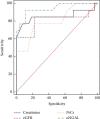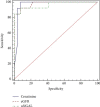Value of Urinary Neutrophil Gelatinase-Associated Lipocalin versus Conventional Biomarkers in Predicting Response to Treatment of Active Lupus Nephritis
- PMID: 33083057
- PMCID: PMC7563084
- DOI: 10.1155/2020/8855614
Value of Urinary Neutrophil Gelatinase-Associated Lipocalin versus Conventional Biomarkers in Predicting Response to Treatment of Active Lupus Nephritis
Abstract
Introduction: Lupus nephritis (LN) affects almost two-thirds of systemic lupus erythematosus (SLE) patients. Despite initial aggressive therapy, up to 25% of patients with LN will progress to permanent renal damage. Conventional serum markers for LN lack the sensitivity of an ideal biomarker. Urinary neutrophil gelatinase-associated lipocalin (UNGAL) is an excellent biomarker for early diagnosis of acute kidney injury and predicting renal outcomes.
Objective: To measure UNGAL among LN patients to correlate its levels with renal disease activity and to investigate its predictive performance in response to induction therapy. Patients and Methods. 40 SLE patients with biopsy-proven LN class III, IV, or V were randomly selected. The study was conducted in the internal medicine department and outpatient clinic in Ain Shams University Hospitals and completed after six months. UNGAL was measured at baseline, three-month follow-up, and after complete induction therapy.
Results: In LN patients at baseline, the mean serum creatinine was 2.57 ± 0.96 mg/dL and the mean UNGAL was 33.50 ± 18.34 ng/dL. Mean UNGAL levels of complete response, partial response, and nonresponse groups were 14.48 ± 2.99 ng/mL, 34.49 ± 4.09 ng/mL, and 62.07 ± 14.44 ng/mL, respectively. Based on the ROC curve, we found a better performance of baseline UNGAL to discriminate the complete response group from partial and nonresponse groups to predict response to induction, outperforming conventional biomarkers. The area under the curve was 0.943, and the best cutoff level was 26.5 ng/mL (92.31% sensitivity and 88.89% specificity).
Conclusion: UNGAL performed better than conventional biomarkers in predicting response to treatment of active LN.
Copyright © 2020 Mohamed Abd El-Mohsen et al.
Conflict of interest statement
The authors declare that they have no conflicts of interest.
Figures


Similar articles
-
The role of urinary neutrophil gelatinase-associated lipocalin in lupus nephritis.Clin Chim Acta. 2013 Oct 21;425:163-8. doi: 10.1016/j.cca.2013.07.030. Epub 2013 Aug 14. Clin Chim Acta. 2013. PMID: 23954775
-
Urinary neutrophil gelatinase-associated lipocalin (uNGAL) and kidney injury molecule-1 (uKIM-1) as markers of active lupus nephritis.Clin Rheumatol. 2024 Jan;43(1):167-174. doi: 10.1007/s10067-023-06698-2. Epub 2023 Jul 29. Clin Rheumatol. 2024. PMID: 37516706 Free PMC article.
-
Polyomavirus BK, BKV microRNA, and urinary neutrophil gelatinase-associated lipocalin can be used as potential biomarkers of lupus nephritis.PLoS One. 2019 Jan 14;14(1):e0210633. doi: 10.1371/journal.pone.0210633. eCollection 2019. PLoS One. 2019. PMID: 30640964 Free PMC article.
-
Urinary neutrophil gelatinase-associated lipocalin for diagnosis and estimating activity in lupus nephritis: a meta-analysis.Lupus. 2015 Dec;24(14):1529-39. doi: 10.1177/0961203315600244. Epub 2015 Aug 27. Lupus. 2015. PMID: 26314302 Review.
-
Elevated Urinary Neutrophil Gelatinase-Associated Lipocalin Is a Biomarker for Lupus Nephritis: A Systematic Review and Meta-Analysis.Biomed Res Int. 2020 Jun 30;2020:2768326. doi: 10.1155/2020/2768326. eCollection 2020. Biomed Res Int. 2020. PMID: 32685458 Free PMC article.
Cited by
-
Comparison urine neutrophil gelatinase - associated lipocalin with standard parameters in monitoring activity Lupus nephritis: Class IV.J Med Biochem. 2023 Jan 20;42(1):78-85. doi: 10.5937/jomb0-35933. J Med Biochem. 2023. PMID: 36819131 Free PMC article.
References
LinkOut - more resources
Full Text Sources

